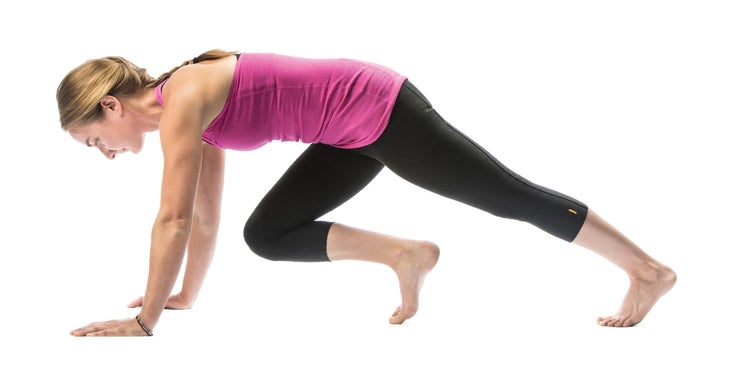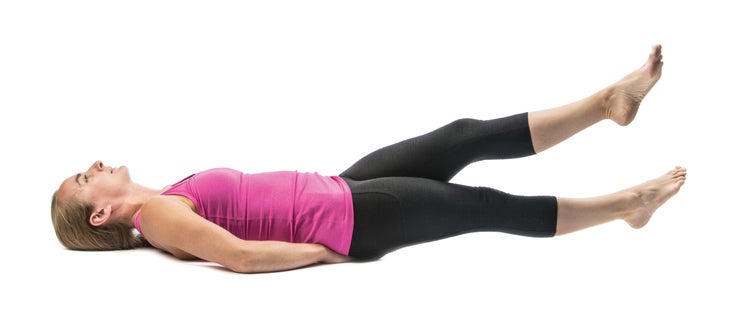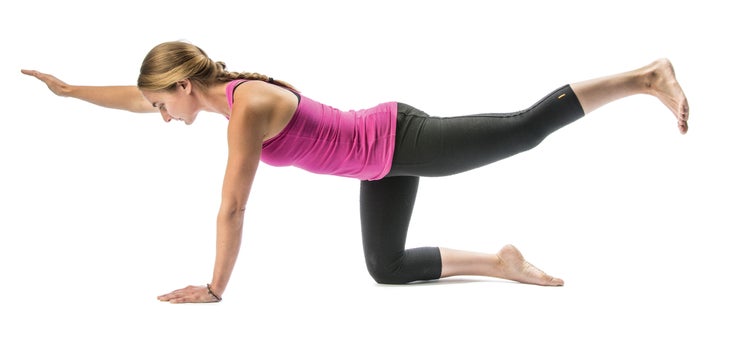Get Fit for Steep Sport Routes in Four Weeks
Robyn Erbesfield-Raboutou's 4-week plan will prepare you for those wicked overhangs.
While most people might jump right on the wall and crank out lap after lap at a comfortable grade, that type of training by itself won’t really help you tick harder grades or improve at steep sport climbing. Ten laps on a 5.10 will help build endurance on other 5.10s, but when it comes time to work that 5.12 project, you’ll be left wanting.
We collaborated with expert trainer, world-champion climber, and famed climbing coach Robyn Erbesfield-Raboutou to create a simple, effective four-week training program that’s designed to have you ready for the killer caves and steep walls of the Red River Gorge. But it’ll also work for your trip to Rifle, or Flatanger, or even Ceuse.
The plan will focus on technique, endurance, core strength, power-endurance, and perhaps the most underestimated but important part of climbing overhangs—resting.
Guidelines
- This four-week program is ideal if you’ve been climbing regularly and are in good shape. If not, start with four weeks of general climbing training to get back in shape. Aim to climb at least three times a week, bouldering, sport climbing, or a combination, either inside or out. Once you have this baseline fitness, begin the specific training outlined here.
- Shoot for climbing-specific training four days a week, in a two days on, one day off pattern, but if you’re feeling really tired, you must take more days off. Rest is just as important as training when you’re going hard. Listen to your body.
- Since this is a shortened, discipline-specific plan, you should be going hard in every session. You should be working at 85 to 100% of your max everyday. Raboutou says, “Why go light? If you’re really tired after one rest day, that’s why you take two.”
- Don’t sacrifice a day at the crag for training inside. Go outside as much as you can, but make it count by mimicking the climbing workout and focus of that particular day.
- Clean up your diet. Don’t count calories, but focus on foods like fruits, vegetables, and lean meats, which are best for intense training periods. Cut out excess sugar, fat, and processed foods. Eat carbohydrates about 30 minutes before training, and then another small serving 15 to 30 minutes right after. See “Nutrition Essentials for Climbers” for more information about what to eat and when.
- If you’re already an enduro-fiend, focus more on power-endurance and consider adding a campus board workout one day a week on an endurance-focused day.
- Each day has a climbing workout (power-endurance or endurance), followed by a specific focus for the day (technique, core, or resting). Pick one workout for both climbing and focus.
- Warm up everyday with 20 minutes of easy climbing.

Practice Resting
1. Pick out a steep route that’s slightly easier than your redpoint max. Climb it once, and figure out where you can get at least two rests. This will help you identify what a good rest is and how to maximize it, as well as how to pace your climbing in between rests. Now re-climb the route, and you must use those two rests for at least 20 seconds each. Arms should be straight, shoulders relaxed, and feet in the best position to take weight off your arms; heel hooks and the like are especially helpful. Focus on using minimal energy, getting your heart rate down, shaking out, alternating hands, and relaxing. Be mentally present when resting: How pumped are you? How does shaking out feel? If you move your foot slightly up or down can you find a better position? Do this with two to three routes; if you fall off at any point, just get back on and complete the route.
2. Create a 20-move boulder problem loop on the steepest part of the bouldering wall. Have it start and end on the same big holds with good feet. Do the problem, and when you get back to the start, rest there without coming off the wall for a set amount of time; three minutes of resting is a good start. Focus on staying relaxed, breathing evenly, shaking out, keeping open hands, not over-gripping, etc. Try to complete the loop at least three times. The next week, create a new problem with a start/end position that has good hands but slightly worse feet. The set resting time might feel too long, but this will get your brain in tune with your body and help you figure out not only how to use rests, but how long you should rest. Create two to three separate problems/loops for each session, aiming to complete each loop three times.
3. Choose an overhanging route at your absolute limit. Climb the route until you feel the pump start to creep in. Keep moving, and right before you feel like you’re going to peel off, find a massive jug—even if it’s not on your route—and milk that rest like there’s no tomorrow. Get into the best resting position you can, using whatever holds are available, whether they’re on your chosen route or not. The idea is to push yourself to your physical limit and then get a break while not dropping off or coming down. Stay there as long as needed, and see how much strength you can get back. It’s fine if you fall two moves later; that’s two more moves than you would have done otherwise. This will build mental fortitude when resting, create confidence, and help you develop a positive attitude about the fact that resting does actually work. Try this with four routes, making sure to rest about 10 minutes between each.
Training Endurance
1. Laps are a great way to gain endurance quickly, but with a limited number of routes in a typical gym, they can get boring really fast. Use this exercise sparingly so you don’t burn out too quickly. They’re just what they sound like: Pick a route a full number grade below your max redpoint and climb it. Lower, pull the rope, and get back on the wall as fast as you can. You don’t have to climb it fast, and you can (and should) rest on the route, but don’t dilly dally about getting back on. Try to gain energy back while on the wall. Run three to five laps on a few climbs, doing a minimum total of 12 pitches.
2. Downclimbing is an underrated training exercise. Not only does it help with footwork and technique, but it also works your main climbing muscles in the opposite direction, like doing “negatives” in weightlifting, where you focus on the lowering portion more than the upward motion. Pick a route that’s a full number grade lower than your redpoint max and climb up. Immediately downclimb the whole thing, and without coming off the wall, start climbing back up. (Using an auto-belay is great for this.) When you get to the top the second time, just lower to the ground. Do this with at least four routes.
3. Pick an overhanging route that’s at least a full number grade below your redpoint max, the juggier, the better. Every time you want to reposition your feet, you must purposely cut both of them, swing them out, and bring them back to the wall in the position that’s necessary to move upward. It should be something like this: Move right hand, move left hand, cut feet, swing them backward, and as you bring your feet back to the wall, place them where they need to go to make the next set of hand movements. Do this on at least six routes, more if you’re an advanced climber.
Core
1. Do all exercises in a row, then repeat each set three to five times, with a 2 min. rest between each set.
- 1 min. forearm plank
- 30 sec. side plank (each side)
- 1 min. mountain climbers
- 2 min. hip bridge
- 10 leg raises on pull-up bar


2. Do all exercises in a row, then repeat each set three to five times, with a 2 min. rest between each set.
- 1 min. bent-leg boat pose
- 1 min. bicycle crunches
- 10 full sit-ups
- 1 min. flutter kicks
- 20 airplanes (alternate sides)



3. Do all exercises in a row, then repeat each set three to five times, with a 2 min. rest between each set.
- 1 min. straight-arm plank
- 1 min. Russian twist with medicine ball
- 15 back extensions/Supermans
- 1 min. leg climbers (alternate sides)
- 30 crunches


Power-Endurance
1. The classic workout to gain power-endurance is a 4×4. On a bouldering wall, find four problems that are about three grades below your redpoint max. Climb the first problem four times without resting, then rest two minutes and climb the second problem four times. Continue until you’ve completed one set. Rest at least five minutes and repeat the 4×4 with four new problems. Rest again and repeat with new problems for three total sets.
2. The treadwall is one of the best climbing inventions since sticky rubber. Kick the angle back so that you can still do four rounds in a row without coming off; 20° is a good starting point. Choose problems that are at least three grades below your max, and then time yourself doing four rounds (same problem repeated or different problems, it doesn’t matter). After the four rounds, rest 1.5 times the length of time it took you; so if it takes you four minutes to do four rounds, rest six minutes. Do at least four sets of this. As you get stronger week by week, try to make the wall a little steeper.
3. Choose 15 boulder problems in the gym that are about three grades below your max, and climb them all in 30 minutes or less—you should have to hustle. Rest 15 minutes, and then climb them all again within 30 minutes.
Refining Technique
1. Bouldering is one of the best ways to gain good technique quickly. Since the problems are short, you can focus on each move and the subtle nuances of footwork, body position, and how to grip slopey or small holds. You’ll also be simultaneously building power, which is often overlooked in sport climbing training, but just as necessary to be successful on challenging routes. Spend 30 minutes projecting hard boulders at your limit.
2. Work with a partner on the systems board. Create problems (usually five to seven moves) that incorporate all different types of movement, holds, and body positions. Focus on your weaknesses, whether it’s a certain type of hold or movement. Since a systems board is mirrored with the same holds in the same spots on each side, make sure to do every problem twice, once on each side. Spend 30 minutes creating problems for each other on the systems board.

Robyn Erbesfield-Raboutou
As one of the leading authorities on coaching climbing for kids, Robyn Erbesfield-Raboutou has trained dozens of youngsters who have sent 5.14 and climbed on the international level. She is a five-time U.S. National Champion and was the third woman in the world to climb 5.14a. She’s also the founder, owner, and director of ABC Climbing in Boulder, Colorado.